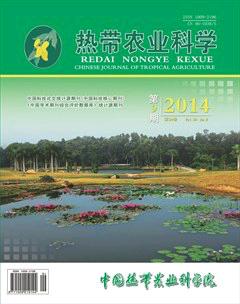真空微波干燥及聯合熱風香蕉片的香氣成分分析
張巖+吳繼軍+林羨+傅曼琴
摘 要 采用氣相色譜/質譜(GC/MS)聯用技術,分別對新鮮香蕉、真空微波干燥、聯合熱風干燥后的香蕉片香氣揮發性成分進行檢測,結果表明:不同干燥方式的香蕉片樣品主成分分析中所含香氣成分都分布在不同象限,有不同的差異,且保留乙酸異戊酯、丁酸異丁酯、丁酸丁酯等與香蕉的特征風味相關的香氣揮發性成分。另樣品中所含香氣成份對熱不穩定,易降解或其它熱反應,同時也會生成一系列具有各自獨特風味的香氣成分。經真空微波干燥處理樣品具丁子香酚甲醚、欖香素等香氣成分,而聯合熱風干燥樣品具不同香型的烯類、酮類化合物。
關鍵詞 香蕉 ;氣相色譜 ;質譜 ;固相微萃取 ;主成分分析 ;質變
分類號 S668.1
Volatile Components Analysis of Banana Chips Treated by Microwave Vacuum Drying and Combined Air Drying
ZHANG Yan WU Jijun LIN Xian FU Manqin
(Sericulture & Farm Produce Processing Research Institute,Guangdong Academy of Agricultural Sciences, Guangzhou, Guangdong 510610)
Abstract The study was carried out to analyze the impact on aromatic compounds of dehydrated chips with microwave vacuum drying (MWVD) and combined microwave vacuum and air drying treatments (MWAD), with a aim of the attributes of the characteristic aroma on quality of banana products. The evaluation was done by analyzing with head space solid phase microextraction-gas chromatography with a mass detector (HS-SPME-GC-MS). Results were used to compare with organic volatiles obtained during microwave vacuum drying and combined with air drying treatment. The research found out different drying methods presented different chromatographic aroma components. Primary component analysis extracted two principal components, which show contribution (>85%) to the total variance of the data set, and it can be clearly seen on score scatter plot. Moreover, In terms of esters fraction, as the important role on volatile compounds of bananas, the sample from MWVD and MWAD chips had the characteristic aroma profiles as fresh banana puree such as isoamyl acetate, isobutyl butyrate, butyl butyrate, while MWVD chips led different volatile aroma retention, which is different from MWAD, volatiles retention with carbonyl fraction of alkenes and ketones during MWAD treatment.
Keywords banana ; GS/MS ; solid phase microextraction ; principal component analysis ; qualitative change
在一些國家和地區,香蕉可作為糧食的替代品,聯合國糧農組織認定它為僅次于水稻、小麥、玉米之后的第四大糧食。香蕉在我國水果總產第四位,次于柑桔、蘋果、梨,在鮮果市場占有重要地位。廣東省2010年香(大)蕉371.27萬t,占全國總產的51%。
由于香蕉是一種典型的呼吸躍變型果實,不耐貯藏,加工過程褐變嚴重,且香蕉的pH 5.0左右,殺菌與保藏困難,加工難度大。水果干燥加工是延長水果貯藏技術之一,如葡萄[1]﹑蘋果片[2]﹑香蕉片[3]干燥。近年來,香蕉片因具綠色天然、營養豐富,兼具口感酥脆、食用方便、易于貯藏等優點受到關注,另外分段聯合干燥技術有助于脫水果蔬干燥產品品質提升。微波-熱風聯合干燥,相對于單一的熱風干燥,熱風-微波聯合干燥能縮短干燥時間30%~50%,減少能耗30%~40%,且產品風味更佳[4-5]。但大多數關于微波干燥的研究都集中在工藝及其影響因素,對產品的風味品質研究較少[6-7]。構成果實香氣的物質主要包括酯類醇類醛類萜類和揮發性酚類物質等[8]。
N.Boudhrioua等[9]研究了成熟香蕉的熱風干燥的風味成份。王娟等[10]采用固相微萃取(SPME)方法提取香蕉的芳香物質,經氣相色譜-質譜聯機(GC/MS)分析,結合計算機檢索技術對分離化合物進行鑒定,應用色譜峰面積歸一法測定各成分的相對含量。檢測了冷凍、帶式干燥、熱風三種干燥方式中香蕉風味的關鍵香氣成分。畢金峰[11-12]認為棗、菠蘿不同干燥方式處理的風味不同,其中熱風干燥處理的棗風味中以酯類和酮類化合物為主,產品具蒸煮味道;菠蘿經變溫壓差膨化干燥醛類風味物質增加,與氨基酸在高溫下分解有關;申建梅[13]檢測結果發現,成熟、未熟階段香蕉香氣成分的種類和相對含量具有明顯差異,尤其乙酸異戊酯、丁酸異丁酯等7種風味物質。朱虹等[14]采用頂空固相微萃取技術提取不同成熟階段香蕉的香氣成分,再經氣質聯用進行分析鑒定。結果發現,在香蕉綠熟、黃熟、過熟階段分析測定宜采用不同DVB/CAR/PDMS型萃取頭。總之香味成分較復雜,香氣成份其感觀閾值較低,含量高但不一定是產品的主導氣味。endprint

